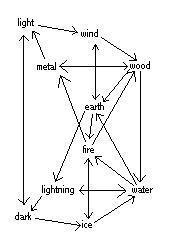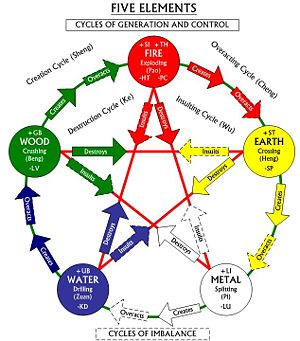
Ah, the elements. These are present in many games in one form or another. I really love them because of the interesting array of strengths and weaknesses they create. So much so that I will detail several of them here.
3-Element System
The first, and simplest. This system makes use of 3 elements. Most characters and enemies have an elemental affinity. Each element resists one and is weak to another, similarly to Rock-paper-scissors. For instance, in Fire Emblem: Path Of Radiance, fire beats wind, wind beats lightning, and lightning beats fire.
Classical Elements
This System was inspired by Aristotle's classical elements. In this type of system, elements oppose each other instead of beating each other. Fire opposes water while wind opposes earth. What this means is that fire-based attacks do extra damage to water-based foes, water-based attacks do extra damage to fire-based monsters, and so on.
Expanded Classical Elements
This system is very similar to the previous. However it adds four new elements: Lightning, ice, light, and darkness. Light opposes darkness, fire opposes ice, lightning opposes water, and wind still opposes earth. This is the system found in most RPGs.
Chinese Elements
Now this one I've never actually seen in action, but I thing would work well in a game. The most notable difference is the addition of wood and metal, replacing wind. Also important is that each element interacts with all the others. The outer ring shows what makes what. Wood fuels fire, fire makes earth (ash), earth contains metal, etc. The inner star shows what damages what. Water puts out fires, fire melts metal, metal cuts wood, etc. It essentially works as a more complicated version of the 3-element system.
Type System
This is the system used in the pokémon series. Basically, each attack carries a type, and each pokemon can have one or two types. Each attacking type does normal damage, half damage, double damage, or no damage at all; depending on the defending pokémon's type. The interactions are mostly based on logic, like water putting out a fire or a flying pokémon being unaffected by earthquakes.
When a pokémon has two types, they may stack. For instance; Scizor, a bug/steel type, takes 4x damage from a fire attack, as both bug and steel are weak to fire, and takes 1/4x from plant-based attacks, as both bug and steel resists them. It also takes normal damage from rock attacks, as while bug-types are weak against rocks, steel-types resist them.
While most pokemon can learn attacks of various typings, an attack gains a 50% boost, called STAB, if the attack type matches one of the user's types. So, Scizor will do 150% of the normal damage when using "steel wing", for example.
Ah... so complicated. This is half the reason I like pokémon.
10-Element Grid

Now, this is one I made myself. It is based primarily on the expanded elemental grid, and partially on the Chinese elements and the type system. It contains fire, water, earth, air, lightning, ice, darkness, light, metal, and wood. The same elements oppose each other as in the expanded elements, and metal opposes wood. In addition, several elements are strong or weak against each other. I designed this grid to be perfectly symmetrical and for each element to have an equal number of strengths and weaknesses.

